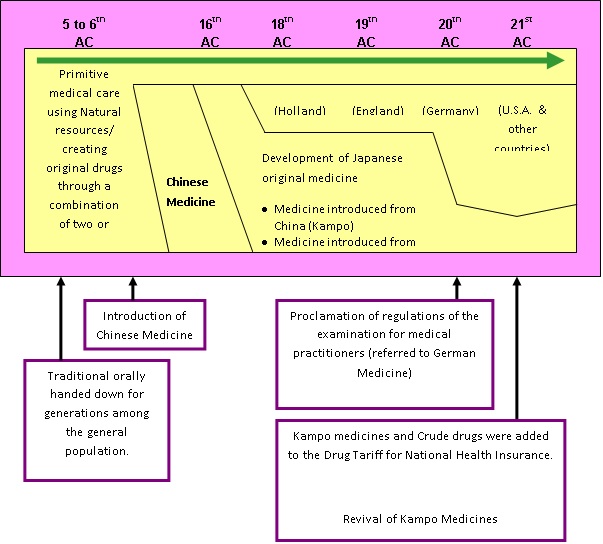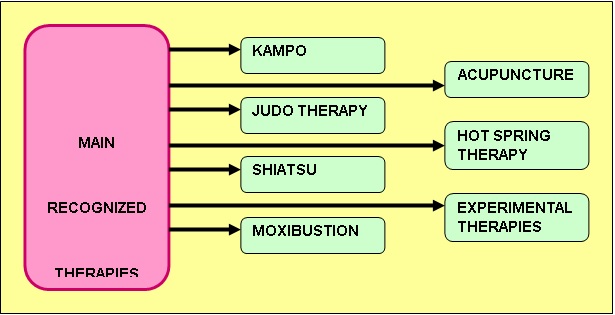Background of Medicinal System
Chronological development
| Century/ Year | Historical milestone |
| Untill 6th Century AD |
|
| 562 |
|
| 7th Century |
|
| 701 |
|
| 794 |
|
| 808 |
|
|
1192-1333 (Kamakura Period) |
|
| Late 14th Century |
|
| 1392-1573 |
|
| 1404-1639 |
|
| 1639 |
|
| Late 17th Century |
|
| 18th Century |
|
| 19th Century |
|
| 1805 |
|
| 1868-1911 (Meiji Era) |
|
| 1872 |
|
| 1874 |
|
| 1886 |
|
| 1914 |
|
| 1937 |
|
| 1943 |
|
| 1961 |
|
| 1976 |
|
| 1979 |
|
| 1985 |
|
| 1988 |
|
| 1997 |
|
| 1998 |
|
| 2001 |
|
| 2002 |
|
| 2005 |
|
Table 1: Chronology of medical system development in Japan
Development of Japanese Traditional medicines and Modern Medicines. [12]

Current Practice
- Allopathic medicine is still the main medicinal system but as CAM growing faster and recognized as legal medical practice for years, Japanese government slowly adapts CAM into medical health care system.[10]
- Recently, Ministry of Health, Labour and Welfare set up an Advisory Panel to investigate CAM specifically for cancer therapy.[10]
- A survey conducted in 2000 stated that 72% of registered allopathic doctors use kampo medicines in their clinical services [13]
- In 2006, the number of practicing doctors was 277 927. [5]
TM/CAM System
Prevalence
- 65.5% of adults in Japan used CAM. [10]
- Kampo medicines is the main traditional medicine been practices in Japan.
- A telephone survey in 2002 showed that respondents who had used at least one CAM therapy in the past 12 months were greater than those who had used orthodox western medicines (76.0% vs 65.6%); 52.1% of the respondents had used both orthodox western medicines and CAM. [10, 14]
- 73% from respondents were practicing complementary medicine, and which the most frequent is Kampo. Other forms of alternative medicine such as chiropractic, yoga, and aromatherapy were practiced by 8% doctors. [10]
Administration
Official Body
- The National Institute of Health Science (NIHS) is a major organization within the Ministry of Health, Labour and Welfare (MHLW) [8]
Main therapies
- Acupuncture, moxibustion, Japanese traditional massage/finger pressure, and judo-therapy are widely practiced in Japan. [13]
Japan has 7 officially recognized therapies. [15]

Policy & Regulations
- There is no information available about Japan’s National Policy on TM/CAM but it is regulates by laws and regulations.[16]
- Japan regulations covers both traditional medicine and herbal products.[15]
- 1870, license of patent medicine [3]
- 1874, the first Medical Act set out qualification requirements for pharmacists [5]
- 1877, regulation of patent medicine [3]
- 1879, regulations of examination for medical practice [5]
- 1880, regulation of pharmaceuticals and European herbal medicines [3]
- 1889, regulation of the sales of pharmaceuticals and European herbal medicines [3] & regulations for drug trade and drug management [5]
- 1914, law of patent medicine for Japanese traditional medicine shops [3]
- 1990, the Society of Japanese Oriental Medicine started a registration system of allopathic physicians specializing in kampo medicine [13]
- 1996, Regulations for Manufacturing Control and Quality Control of Drugs [13]
- 1999, the Japan Society for Acupuncture and Moxibustion began a registration system for allopathic medical doctors specializing in acupuncture and moxibustion. [13]
- List of Law regulates TCAM practices in Japan :
- Standards for medicinal plant materials; [13]A law in the year of 1883 ruled that no Kampo physician was officially licensed as a medical doctor. [2]
-
Japanese Pharmacopoeia
-
Japanese Herbal Medicine Codex
-
Japanese Standards for Herbal Medicines
-
Facilities
- In 1979, a Department of Japanese Oriental (Kampo) Medicine Clinic at Toyama Medical and Pharmaceutical University was built.
- 1991, Osaka Medical College
- 1992, Tokyo Women’s Medical College
- 1993, Keio University
- 1994, The University of Tokyo [17]
Insurance coverage
- In 1976, the National Health Insurance covering Kampo drugs was established.[4]
- In 2000, the National health insurance reimbursement list covers 148 prescription Kampo formulae and 192 herbal materials used in prescription Kampo formulae.[13]
- The public health insurance covers acupuncture [10], moxibustion, Japanese traditional massage (An-ma), Finger Pressure (Shiatsu) and Judo therapy.[11,13]

Research Institute/s
- In 2003, Japanese government allocated almost USD 1.33 million subsidies for a total 45,273 research studies at universities and national or private institute laboratories. Part of the studies were in the field of traditional medicine. [12]
- Among the important research institutes are:
- National Institute of Health Sciences, Tsukuba [8]
- Department of Japanese Oriental Medicine, Toyama Medical and Pharmaceutical University, Toyama
- Tohoku University
- Oriental Medicine Research Center, The Kitasato, Tokyo
- Research Institute of Oriental Medicine at Tokyo Women’s Medical College [17]
- The Experimental Station of Medicinal. [8]
- The Research Institute for Natural Medicines. [13]
- The Biological Safety Research. [8]
- The International Research Centre for Traditional Medicine in Toyoma prefecture.[9,10]
- The Division of Cellular and Gene Therapy Products, the Division of Biomedical Food Research, and the Division of Medical Safety Science in the NIHS [8]
- The National Institute of Biomedical Innovation
Training & Education
- The Japan Pharmacists Education Centre issues a certificate for pharmacists specializing in kampo medicines and herbal materials but it needs to be renewed every three years. [13]
- A person needs to pass the national examination after 3 years of education at professional school in order to obtain a license of acupuncture, moxibustion, acupressure or massage. [9,10]
- National license for Judo-Orthopedics can be obtained after 3 years of education under licensed Judo orthodedicians. [9,10]
- The Japan Pharmacists Education Centre launched a special training course on kampo medicine and herbal materials in year 2000 with collaboration with the Japanese Society of Pharmacognosy [13]
- The study of Kampo medicine was not included into the medical education since the Meiji era. Only 6 out of 80 medical schools provide traditional techniques training. [4]
- A small research group of physicians for CAM was born at Kanazawa University in 1990. [10].
- National survey on 1998 reported 18 medical schools have either an elective or required class on complementary/alternative medicine mainly kampo medicine and/or acupuncture. [13]
- Each year the Japan Society for Oriental Medicine offers a summer programme in Kampo medicine for 60 undergraduate students of allopathic medical schools since 1998. [13]
- 80 medical schools offered six-years allopathic medical programmes in the year of 2000. [13]
- In 2002, government has introduced Kampo into the core curriculum of medical and pharmaceutical education. [2,18]
- In 2003, the Ministry of Education and Science of Japan recommend all medical schools in Japan to include a course giving and overview of Kampo within the core curriculum for medical students. [2] CAM was integrated into educational system of the Yamanashi nursing college. [9]
- Complementary medical courses such as acupuncture and Kampo being taught in only 20% of medical schools. [10,19]
- Japan doesn’t have yet any official education covering for both traditional medicine and alternative medicine for doctors, pharmacist and nurses at university level.[19]
- 46 colleges and universities offers four year undergraduate programmes in pharmaceutical sciences with traditional medicines as part of the curriculum. [13]
- All 80 medical schools in Japan’s universities offers undergraduate education program for Kampo medicine.[12]Training in Kampo techniques was offered as optional lecture courses of varying lengths or part of clinical medicine curriculum for the Western-style medical degree programs students at the University of Tokyo, Keio University and Osaka Medical College. [17]
- University of Tokyo,
- Toyama Medical and Pharmaceutical University,
- Keio University,
- Osaka Medical College
- Research Institute of Oriental Medicine at Tokyo Women’s Medical College.[17]
- Toyama Medical and Pharmaceutical University is the only officially recognized undergraduate medical curriculum which teach kampo medicine alongside allopathic medicine and offers a four-year postgraduate Doctorate and two-year Master’s programmes in kampo medicine. [13]
- 22 schools and training institutions offer three-year programmes in acupuncture and moxibustion, while one university offers a four-year programme. 87 schools and training institutions offer a joint programmes in acupuncture, moxibustion and Japanese traditional massage/finger pressure. [13]
- 91 schools and training institutions offers a three-year programme only in Japanese traditional massage/finger pressure. [13]
- 25 schools and training institutions offer three-year programmes in judotherapy [13]
- There were 31 schools and training institutions offer three-year programmes in Japanese traditional massage/finger pressure for the visually impaired persons while seven schools and training institutions offer five-year joint programmes in acupuncture, moxibustion, and Japanese traditional massage/finger pressure. [13]
Links
- Ministry of Health, labour and Welfare : http://www.mhlw.go.jp/english/
Special Issue/s regarding the country
- In Japan, physicians are specially allowed legally to practices both traditional medicines and western medicine in clinical practices.[15]
References
- Ishibashi A, Kosoto H, Ohno S, et al. General introduction to kampo. In: Sato Y, Hanawa T, Arai M, et al, editors. Introduction to kampo: Japanese traditional medicine. Tokyo, Japan: Elsevier, 2005; p. 2-13.
- Terasawa K. Evidence-based reconstruction of kampo medicine: part 1 – is kampo CAM? Evid Based Complement Alternat Med. 2004;1(1):11-16.
- Saito H. Regulation of herbal medicines in Japan. Pharmacol Res. 2000;41(5):515-519.
- Matsumoto M, Inoue K, Kajii E. Integrating traditional medicine in Japan: the case of kampo medicines. Complement Ther Med. 1999;7:254-255.
- Tatara K, Okamoto E. Health systems in transition. Japan: health system review. 2009;11(5):1-164.
- Sakai S. History of medical care at inpatient facilities in Japan. JMAJ. 2011;54(6):351-356.
- Kobayashi Y. Five decades of universal health insurance coverage in Japan: lessons and future challenges. JMAJ. 2009;52(4):263-268.
- National Institute of Health Sciences. [homepage on the Internet]. c2006. No date [cited 2016 Aug 29]. Available from: http://www.nihs.go.jp/english/nihs/index.html
- Cooper EL, Yamaguchi N, editor. Complementary and alternative approaches to biomedicine. New York: Kluwer Academic/Plenum Publishers; 2004.
- Suzuki N. Complementary and alternative medicine: a Japanese perspective. Evid Based Complement Alternat Med. 2004;1(2):113-118.
- Kawashima A, Madarame T. Clinical practice of integrative medicine in the university. Jpn J Complement Alternat Med. 2005;2(1):75-79.
- Country report for ASEAN ad-hoc working group meeting on traditional & complementary medicine (AWGTCM). Penang, Malaysia; 2004 April 17.
- World Health Organization. Legal status of traditional medicine and complementary/alternative medicine: a worldwide review. Geneva: World Health Organization; 2001.
- Yamashita H, Tsukayama H, Sugishita C. Popularity of complementary and alternative medicine in Japan: a telephone survey. Complement Ther Med. 2002;10(2):84-93.
- Cyong, Jong-Chol. Other therapies. In: Sato Y, Hanawa T, Arai M, et al, editors. Introduction to kampo: Japanese traditional medicine. Tokyo, Japan: Elsevier, 2005; p. 207-216.
- World Health Organization. National policy on traditional medicine and regulation of herbal medicines – report of a WHO global survey. Geneva: World Health Organization; 2005.
- Tsumura & Co. Report on outpatient clinics at university hospitals provides snapshots of kampo therapeutics in Japan. Kampo Today [serial online]. c2003 [cited 2016 Sept 1]; 1(2). Available from: Kampo Today: News of Japanese Herbal Medicine.
- Yamada H. Japan. In: Bodeker G, Ong CK, Grundy C, Burford G, Shein K, editors. WHO global atlas of traditional, complementary and alternative medicine. Kobe, Japan: WHO Centre for Health Development, 2005; p. 193-198.
- World Health Organization. WHO traditional medicine strategy 2002 – 2005. Geneva: World Health Organization; 2002.

